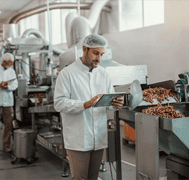 In recent years, food management has become increasingly sophisticated thanks to developments in advanced data analytics, artificial intelligence, the Internet of Things (IoT), and the cloud. Digital food management can optimize manufacturing processes, supply chain operations, marketing strategies, and more benefiting stakeholders from farm to table including producers, vendors, and restauranteurs alike.
In recent years, food management has become increasingly sophisticated thanks to developments in advanced data analytics, artificial intelligence, the Internet of Things (IoT), and the cloud. Digital food management can optimize manufacturing processes, supply chain operations, marketing strategies, and more benefiting stakeholders from farm to table including producers, vendors, and restauranteurs alike.
Unsurprisingly, with increasing demand for healthier, cheaper, and safer food products, the worldwide food technology market is expected to exceed 340 billion USD by 2027.
Here are some advantages you can leverage by digitalizing your food management systems.
Better Quality
The IoT gives you greater visibility into food production by integrating the various machines and assembly line processes into one data system, providing producers the necessary insights to make improvements and drive better results. Sensors can track and update information regarding temperature and humidity to inform shipping times, for example. Being able to monitor large food production systems can uncover issues in real-time, reducing downtime and other problems.
The large volume of data generated through production operations can be stored in the cloud, which can be effortlessly merged with other sources from anywhere. You could use this data for predictive maintenance, reducing costs and downtime while increasing line productivity.
Demand Forecasting
Each year, the food industry loses billions from either having too little or too much food. According to recent studies, stockouts account for more than $630 billion in lost sales globally, and overstocks represent over $470 billion in losses due to markdowns. Considering fresh produce, which has a shelf life of about a week, makes up 40 per cent of retailers’ sales, there is a very small window of opportunity to get it right.
Restaurants and manufacturers can use advanced data analytics to study consumer behaviour to forecast demand. Wasting hours sifting through old logbooks is no longer sustainable in today’s economy. Digital technology and software like ERP systems can process large data sets easily and make long-term demand forecasting possible, giving the food industry the necessary agility to react to market forces in real-time.
Less Wastage
Here are some facts and figures to consider:
- Food waste is responsible for about 7 per cent of global greenhouse gas emissions
- One-third of all good produced globally is wasted yearly
- The resources need to produce that wasted food has a carbon footprint of over 3 billion tons of CO2
- Anywhere from 4 to 10 per cent of the food purchased by restaurants is wasted before reaching the customer
Digital food management can not only help the food industry improve food quality while becoming more profitable, but it can also help make the industry more environmentally friendly.
We Know Your Industry
SHEA has the digital solutions to improve your food management systems and processes. We can help you manage your inventory with software like Dynamics GP, gain control over your manufacturing, distribution, and accounting with SYSPRO, and develop your cloud computing with Azure.
Contact us today to learn how we can help you improve your business efficiencies at https://sheaglobal.com.